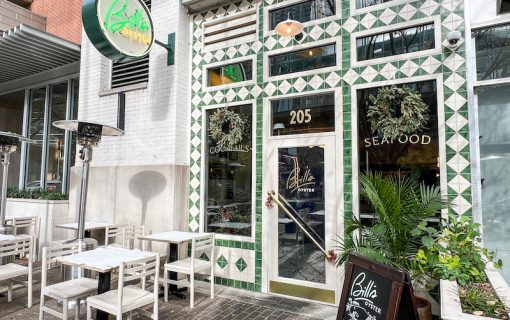While Austin has plenty of bands playing around town every night of the week, it occasionally it gets big names that include Austin as part of their Texas tour routing. One of these bands is ’80s British band Culture Club, fronted by its most well-known member, Boy George. The band is currently in the middle of an ambitious 50-date comeback tour after going on hiatus for the third time in 2004.
Culture Club is playing four dates in the Lone Star State, and Austin is their first stop. They’ll be performing at Austin’s newest venue, the Skyline Theatre, on August 2nd. Built this past spring, the 7,000 seat venue located next to The Long Center, gives residents and tourists a taste of downtown while experiencing sunsets and a stunning view of the city skyline that you won’t be able to see anywhere else. Fantastic sound is something you’ll get as well, allowing you to experience hearing the group’s hits as well fan favorites.
Culture Club formed in 1981 and went on to become one of the most recognized musical and cultural icons of the ’80s with hits such as “Karma Chameleon” (Colour By Numbers, 1983) and “Time (Clock of the Heart)” from their debut record Kissing To Be Clever, released in 1982. After performing at London’s Blitz Club on a regular basis, Boy George, who founded the group, decided to start a band.
Enlisting bassist Mikey Craig, drummer Jon Moss, and Roy Hay on guitar, they came up with the name Culture Club to celebrate each member’s heritage, once they realized that they had an Irish gay man on vocals, a black Briton on bass, an Anglo-Saxon on guitar, and a Jewish drummer. After a few false starts with demos and record signings, Virgin Records signed the group in the UK, while Epic Records took over in the US.
After several successful releases throughout the world in the ’80s, the lights started to dim in 1986 with the release of their 4th LP From Luxury To Heartache and the once-popular group decided to disband that same year. After four years apart, Culture Club tried to reconcile again at the insistence of the group’s former manager along with Boy George’s management. Though the band recorded songs, Boy George was more excited about his own upcoming projects than performing with Culture Club.
The band would be inactive again until 1999, when the band dropped their fifth album, Don’t Mind If I Do, released only in their native England. Receiving only modest success, the band disbanded again, due to Boy George’s successful DJ career. After Craig and Moss decided to tour with a replacement singer several years later, it would not be until the mid-2000s that the band would come together for their most permanent reunion in years.
Looking forward to the release of their LP Tribes, Culture Club is happy to be back on stage, doing what they do best. Austin.com checked in with guitarist Roy Hay about where they have been, the tour, and their upcoming record.
He kicked off the conversation by telling us about the band’s sometimes dysfunctional relationship, though despite this, the band gels together well. “Culture Club is an interesting thing, it’s like a Thanksgiving dinner, when a dysfunctional family reunites. But there is a moment when all of that goes away and we are on stage playing our music. It’s such a privilege to be able to do that, and everyone’s really enjoying it,” Hay said.
“We are always good for a reunion every fifteen years or so, but as times goes by, we all have much appreciation for the band. I think we realize how difficult it is to find that magic in life, and when you find it, it’s like, you can’t that for granted. Sometimes I think over the years, we took things a little bit for granted, and then we go off and do other things. But then we come back and we realize how great the band is. The guys play so well and we fit together so well as a band, it’s uncanny, actually,” Hay recalled. “You can’t really put it into words, there’s a sort of madness to the way we all play together, as everyone brings something completely unique, and when it works and we are in the groove on stage, the universe aligns.”
Discussing the 1989 hiatus, Hay tells us “I moved to LA in 1989, and I wrote songs for a bunch of people and produced, I wrote songs for commercials, I wrote with Hans Zimmer the composer for a while doing film stuff. I did music for TV, a show called “The Dead Zone” and a show called “Cracker.” When it’s in you, it’s kind of what you do, really. I’m a musician man, and that’s what I do, really. It all kind of leads back to where you started in a way, and what we are doing is more special than anything else. We’ve all had success in other areas, but I think the real pinnacle and the thing that defines our success is always going to be Culture Club. I think people really enjoy coming and hearing those songs again, and feeling the energy of the band.”
When asked what the other band members were doing during this period, Hay tells us that everyone was playing music. “Mikey was playing with Kid Creole and the Coconuts, and Jon’s always playing in bands around London. George is DJing and releasing solo albums. He always seems to be busy, I love what he does, but he always seems to be busy.” Since Culture Club formed in the late ’80s, when music had a distinctive style with unique characteristics, we asked Hay how the band maintains relevancy among music fans today, as the younger generation didn’t exist when Culture Club was popular. He gave a surprising answer to our question.
“The demographics are quite open, actually. There is 60% to 70% from our generation who are coming out to shows from the nostalgia point of view, and then we also get the Generation X crowd who may say ‘I remember those songs, what were they?’, so we get a pretty interesting crowd,” Hay said. “We actually have some young people coming, too, which is interesting. I think music can break those barriers, and if your band is good and the songs survive, people will always come and see you. But it’s a real party at a Culture Club show, you know. I think we’re morphing into a new version of Earth, Wind, and Fire. We play the old hits, some cover tunes, some funky new songs, but really it’s just one big party.”
Veering away from the discussion about the tour, we were curious to know Hay’s take on streaming and how music is now consumed due to his long career as a musician. Knowing that Hay has listened to music through every platform imaginable, from vinyl, to tapes, to CD’s, and finally to streaming, we wanted to get his take on how we listen to music today.
“We’ve made a new album, but we’ve been sitting on it, and we don’t want to put it out because we feel like it could just disappear. We’ve gone out and played some live shows and get people of band the band again, because we feel it’s a pretty precious thing. It’s become easy to dismiss music, and there’s no respect for people’s art. People don’t just give paintings or TV shows away. I’m quite precious about my art. I don’t particularly like what Google and Apple have done to music. Easy access doesn’t always mean better for people. Change is okay if it’s for the better, but I think we’ve lost something along the way. I think we’ve lost the respect for people’s art.”
Art and individuality is something that has always been at the core of the Culture Club sound, a trait that the band carries with them today. Wanting to give their fans something special is an important piece of the Culture Club mentality, and fans can expect to see a top notch show from their favorite nostalgia act.
Listen to “Karma Chameleon” below.
Featured photo: Culture Club, Hollywood Bowl

If you would like to read more of Lauren Gribble’s interviews, you can head to her website Listen Here Reviews.







